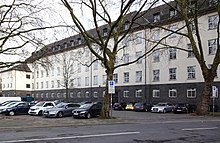Phoenix house
The Phoenix-Haus (alternative spelling Phönix-Haus) is a listed administrative building at Fritz-Roeber-Straße 2 in Düsseldorf's old town , which was built from 1923 to 1926 for Phoenix AG for mining and smelting operations on the former Eiskellerberg , almost seven Has served as an employment office for decades and has been the Düsseldorf public prosecutor's office since 2002.
description
The building is made entirely of brick expressionism with a diamond-shaped, pointed pattern on the surface. The building is a three-wing complex. The entrance area shows arcades consisting of three round arches. The brick facade surface shows a grid-like structure. The building sculpture is integrated with sculptures by Ludwig Gies . Above the entrance area, which is separated from the upper floor by a cornice, there are rectangular windows and above them round windows. The facade ends in a classicistic triangular gable. Despite war damage, the old building structure has been preserved. The main staircase has been completely preserved, along with individual stucco ceilings, doors and lamps.
history
In 1922, Phoenix AG relocated its headquarters to Düsseldorf. An architectural competition was organized for the new company headquarters , in which Karl Beck's design won first prize. However, Beck died before construction began. Taking these plans into account, the building was constructed under the direction of the architect Karl Wach . Phoenix AG was merged with Vereinigte Stahlwerke AG in 1926 , which moved to the Neue Stahlhof in 1928 . The Phoenix House was then used as an employment office from 1928 to 1995. The building was damaged in World War II, lost the roof, and was later topped up. In 1988 the building was listed as a historical monument. In 2002 the building complex was expanded and renovated in coordination with the monument protection authority for the new user, the Düsseldorf public prosecutor's office.
literature
- Jörg AE Heimeshoff : Listed houses in Düsseldorf, with garden and ground monuments. Nobel, Essen 2001, ISBN 3-922785-68-9 , p. 98.
Web links
- Building Fritz-Roeber-Straße 2 in the monument list of the state capital Düsseldorf at the Institute for Monument Protection and Preservation
- Website HPP Architects: Phönix-Haus: Renovation under monument conservation aspects: 2002 . Retrieved January 26, 2011
- Website of the public prosecutor's office in Düsseldorf: The public prosecutor's office in Düsseldorf through the ages . Retrieved January 26, 2011
Individual evidence
- ^ Friedrich-Wilhelm Henning: Düsseldorf and its economy. About the history of a region. Volume 2: From 1860 to the present . Droste, Düsseldorf 1981, ISBN 3-7700-0595-3 . P. 593
- ^ Jörg AE Heimeshoff: Listed houses in Düsseldorf, with garden and ground monuments. Nobel, Essen 2001, ISBN 3-922785-68-9 , p. 98.
Coordinates: 51 ° 13 ′ 50.1 ″ N , 6 ° 46 ′ 35 ″ E


